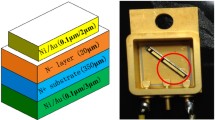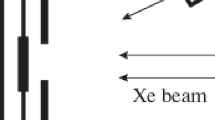Abstract
Silicon carbide (SiC) detectors based on Schottky diodes were used to monitor low and high fluxes of photons and ions. An appropriate choice of the epilayer thickness and geometry of the surface Schottky contact allows the tailoring and optimizing the detector efficiency. SiC detectors with a continuous front electrode were employed to monitor alpha particles in a low-flux regime emitted by a radioactive source with high energy (>5.0 MeV) or generated in an ion implanter with sub-MeV energy. An energy resolution value of 0.5% was measured in the high energy range, while, at energy below 1.0 MeV, the resolution becomes 10%; these values are close to those measured with a traditional silicon detector. The same SiC devices were used in a high-flux regime to monitor high-energy ions, x-rays and electrons of the plasma generated by a high-intensity (1016 W/cm2) pulsed laser. Furthermore, SiC devices with an interdigit Schottky front electrode were proposed and studied to overcome the limits of the such SiC detectors in the detection of low-energy (∼1.0 keV) ions and photons of the plasmas generated by a low-intensity (1010 W/cm2) pulsed laser. SiC detectors are expected to be a powerful tool for the monitoring of radioactive sources and ion beams produced by accelerators, for a complete characterization of radiations emitted from laser-generated plasmas at high and low temperatures, and for dosimetry in a radioprotection field.
Similar content being viewed by others
References
A. Owens and A. Peacock, Nucl. Instr. Methods A 531, 18 (2004).
F. Nava, G. Bertuccio, A. Cavallini, and E. Vittone, Meas. Sci. Technol. 19, 102011 (2008).
E.V. Kalinina, A.M. Ivanov, and N.B. Strokan, Tech. Phys. Lett. 34, 210 (2008).
F.H. Ruddy and J.G. Seidel, Nucl. Instr. Methods B 263, 163 (2007).
S. Seshadri, A.R. Dulloo, F.H. Ruddy, J.G. Seidel, and L.B. Rowland, IEEE Trans. Electr. Dev. 46, 567 (1999).
G. Bertuccio and R. Casiraghi, IEEE Trans. Nucl. Sci. 50, 175 (2003).
F. Nava, E. Vittone, P. Vanni, P.G. Fuochi, and C. Lanzieri, Nucl. Instr. Methods A 514, 126 (2003).
B. Zat’ko, F. Bubecky, A. Sagatova, and L. Ryc, J. Instrum. 10, C04009 (2015).
Y.B. Gurov, S.V. Rozov, V.G. Sandukovsky, E.A. Yakushev, L. Hrubcin, and B. Zat’ko, Instrum. Exp. Tech. 58, 22 (2015).
L. Liu, J.L. Liu, L. Chen, Z.B. Zhang, P. Jin, J.L. Ruan, G. Chen, A. Liu, S. Bai, and X.P. Ouyang, Diam. Rel. Mater. (2016). doi:10.1016/j.diamond.2016.09.011.
M. Napoli, F. Giacoppo, G. Raciti, and E. Rapisarda, Nucl. Instr. Methods A 608, 80 (2009).
G. Bertuccio, R. Casiraghi, A. Cetronio, C. Lanzieri, and F. Nava, Nucl. Instr. Methods A 522, 413 (2004).
S.K. Chauduri, K.J. Zavalla, and K.C. Mandal, Nucl. Instr. Methods B 728, 97 (2013).
S. Sciortino, F. Harties, S. Lagomarsino, F. Nava, M. Brianzi, V. Cindro, C. Lanzieri, and P. Vanni, Nucl. Instr. Methods A 552, 138 (2005).
G. Raciti, M. Napoli, F. Giacoppo, E. Rapisarda, and C. Sfienti, Nucl. Phys. A 834, 784 (2010).
P. Musumeci, M. Cutroneo, L. Torrisi, A. Velyhan, M. Zimbone, and L. Calcagno, Phys. Scr. T161, 014021 (2014).
L. Torrisi, M. Cutroneo, G. Ceccio, A. Cannavò, D. Batani, G. Boutoux, K. Jakubowska, and J.E. Ducret, Phys. Plasm. 23, 043102 (2016).
A. Sciuto, L. Torrisi, A. Cannavo, G. Ceccio, P. Musumeci, M. Mazzillo, and L. Calcagno, Vacuum 131, 170 (2016).
F.H. Ruddy, J.G. Seidel, H. Choen, A.R. Dulloo, and IEEE Trans, Nucl. Sci. 53, 1713 (2006).
L. Torrisi, S. Gammino, L. Andò, and L. Laska, J. Appl. Phys. 91, 4685 (2002).
A. Itoh, T. Kimono, and H. Matsunami, IEEE Electr. Dev. Lett. 17, 139 (1996).
L. Calcagno, A. Ruggiero, F. Roccaforte, and F. La Via, J. Appl. Phys. 98, 0237131 (2005).
S.M. Sze, Semiconductor Devices Physics and Technology (New York: Willey, 1985).
CXRO, X-Ray Interactions With Matter, Actual website (2017) http://henke.lbl.gov/optical_constants/.
J. Ziegler, SRIM, The Stopping and range of ions in Matter, actual website (2013) http://www.srim.org/.
A. Sciuto, F. Roccaforte, S. Di Franco, V. Raineri, and G. Bonanno, Appl. Phys. Lett. 89, 081111 (2006).
Amptek website. http://amptek.com/products/ mini-x-rays-tube/ (2016).
G.F. Knoll, Radiation Detection and Measurement, 3rd ed. (NewYork: Wiley, 2000), p. 466.
T. Yamaya, R. Asano, H. Endo, and K. Umeda, Nucl. Instr. Methods 159, 181 (1979).
L. Torrisi, A. Sciuto, A. Cannavò, S. Franco, M. Mazzillo, P. Badalà, and L. Calcagno, J. Electr. Mater. (2017). doi:10.1007/s11664-017-5379-y.
J.W. Mayer and E. Rimini, Ion Beam handbook for Materials analysis (New York: Elsevier Science, 1977).
Y. Zhang, B.D. Milbrath, W.J. Weber, M. Elfman, and H.J. Whitlow, Appl. Phys. Lett. 91, 094105 (2007).
L. Torrisi and A. Cannavò, IEEE Trans. Electron Dev. 63, 4445 (2016).
L. Torrisi, Radiat. Eff. Defect Solids 171, 34 (2016).
L. Torrisi, S. Gammino, L. Andò, L. Laska, J. Krasa, K. Rohlena, J. Ullschmied, J. Wolowski, J. Badziak, and P. Parys, J. Appl. Phys. 99, 083301 (2006).
A. Sciuto, F. Roccaforte, S. Franco, V. Ranieri, S.F. Liotta, S. Billotta, G. Bonanno, and M. Belluso, Mater. Sci. Forum 556, 945 (2007).
H. Shuoben, P. Hellström, C.M. Zetterling, and M. östling, IEEE Electr. Dev. Lett. 37, 1594 (2016).
Acknowledgements
Authors thank the INFN-LNS of Catania (Italy) for the useful support given using the low intensity Nd:YAG laser and the PALS Laboratory in Prague (Czech Republic) for the facility given by the LaserLab-Europe Project N. Pals 1823-Prof. L. Torrisi.
Author information
Authors and Affiliations
Corresponding author
Rights and permissions
About this article
Cite this article
Sciuto, A., Torrisi, L., Cannavò, A. et al. Advantages and Limits of 4H-SIC Detectors for High- and Low-Flux Radiations. J. Electron. Mater. 46, 6403–6410 (2017). https://doi.org/10.1007/s11664-017-5675-6
Received:
Accepted:
Published:
Issue Date:
DOI: https://doi.org/10.1007/s11664-017-5675-6




